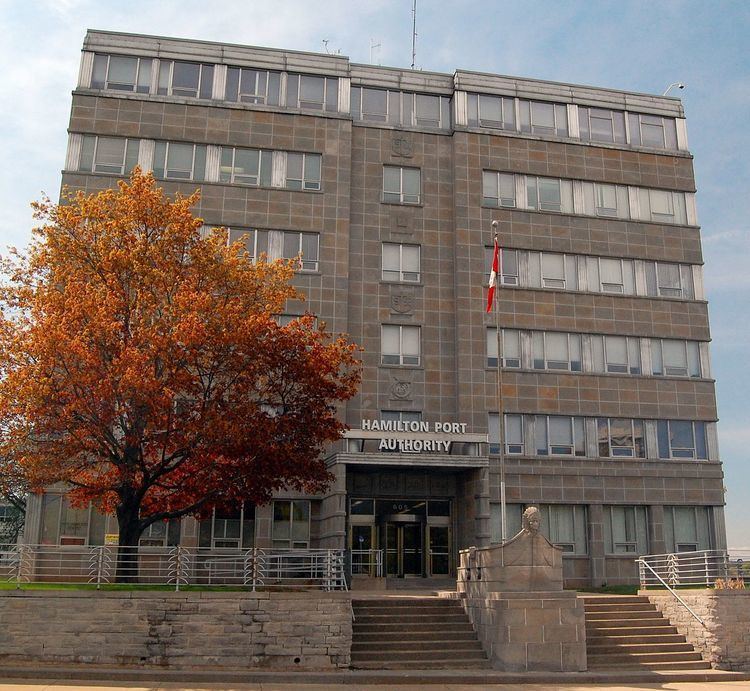Country Canada Opened 1912 President and CEO Ian Hamilton Headquarters Hamilton, Canada Net income 1.78 million CAD (2014) | Location Hamilton, Ontario Size 620 acres (250 ha) CEO Bruce Wood (Mar 2008–) Founded 1 May 2001 | |
 | ||
Annual cargo tonnage 10.5 million metric tons (FY2014) | ||
Hamilton port authority 2015
The Hamilton Port Authority, created in 2001, replaced the Hamilton Harbour Commission. It derives its mandate from the Canada Marine Act, an act of Canada's federal Parliament. Hamilton is one of 19 Canadian ports that had port authorities created, because they were deemed essential to Canada's economic welfare.
Contents
- Hamilton port authority 2015
- Hamilton port authority
- History
- Hamilton Port Authority Building
- Port Facilities
- References
The Port of Hamilton is the largest port in Ontario by tonnage, handling approximately 10 million tonnes of mixed cargo, and receiving approximately 650 vessels per year.
The Port of Hamilton is located in Hamilton Harbour, at the far western end of Lake Ontario, connected to the Great Lakes-St Lawrence Seaway shipping network. With multiple Seaway-depth berths, the Port of Hamilton can facilitate marine shipments throughout the Great Lakes, and international waters.
More than 620 acres of land is owned by the Hamilton Port Authority. This harbourfront land houses a variety of businesses, primarily related to logistics and transportation for key regional industries: steel, manufacturing, agri-food and construction materials.
A 2010 study by Martin and Associates revealed that cargo transiting the Port of Hamilton is connected to $6 billion in economic activity and 38,000 jobs in the province of Ontario.
In 2013 a controversy was triggered when no organization in Hamilton was available to fight a highly visible marine fire. According to CBC News, neither Hamilton Fire Services or Hamilton Police Service thought they had a mandate to fight marine fires. The port authority had once operated a tugboat with some firefighting ability, but that vessel was no longer operational.
The port authority's mandate includes managing valuable waterfront properties. According to the Hamilton Spectator, in October 2013 Bruce Wood, the President of the Port Authority, speculated that the recent announcement that US Steel would be closing its last steel mill in Hamilton represented an opportunity for the Port Authority to buy the 328 hectares (810 acres) site of that mill, which could then be made available for other industrial entreprises, who would then create new jobs there.
The Port Authority reported that the volume of cargo shipped through the port remained stable in 2013, with grain shipments up and shipment related to the steel industry down. The amount of cargo shipped by rail went up, while cargo shipped by water went down.
Hamilton port authority
History
On April 1, 1912, an Act of Parliament created the Hamilton Harbour Commissioners (HHC) and on May 1, 1912, the first three Harbour Commissioners, George J. Guy, Hugh S. Wallace and William J. Clark took their oaths of office.
The Port of Hamilton grew throughout the 20th century, in service to Hamilton’s two major steel producers, Steel Company of Canada , and Dominion Steel Castings Company , as well as Hamilton’s robust manufacturing economy.
The long-awaited completion of the Welland Ship Canal in 1932 brought a tremendous boost in shipping to Hamilton industry. Anticipating the arrival of larger Great Lakes vessels and ocean freighters, the Commissioners had already widened and deepened the canal entrance from Lake Ontario into Hamilton Harbour. In order to accommodate the huge ore and coal ships which now had direct access to Harbour waters, the Steel Company of Canada and the Hamilton By-Product Coke Ovens constructed larger docks. The result: between 1929 and 1934 total tonnage in the harbour doubled from one to two million tonnes annually, making Hamilton the fourth-busiest port in the country, behind Montreal, Vancouver and Toronto.
When the St. Lawrence Seaway opened in 1959, the first ship travelling up the new system berthed in Hamilton. Cargo tonnage after the first year of Seaway operation was higher in Hamilton than at any other Canadian or American Port on the Great Lakes.
Hamilton Port Authority Building
Completed in 1953, Hamilton Port Authority Building is an example of Art Deco architecture in Hamilton. The building is complimented by Art Deco sculptures by Louis Temporale.
Port Facilities
The Port of Hamilton handles a diversified mix of cargoes:
The Port of Hamilton houses multiple terminal operations, providing storage and transloading of dry and liquid bulk commodities, breakbulk and project cargo. The port is served by two stevedores: Federal Marine Terminals and Great Lakes Stevedoring, and by two Class-1 North American railways: CN and CP.
